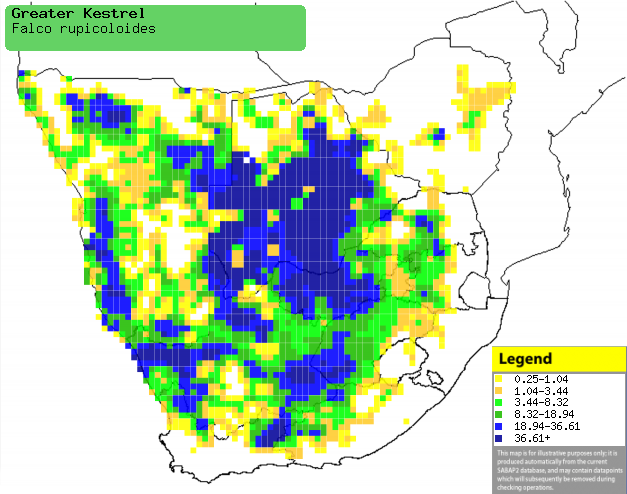|
Falco rupicoloides (Greater
kestrel)
Grootrooivalk [Afrikaans]; Kakodi (generic term for
sparrowhawks, goshawks, kestrels and falcons) [Kwangali]; Seotsanyana (applied
also to other kestrel species and to Amur falcon) [South Sotho]; Phakalane
(generic term for some of the smaller raptors) [Tswana]; Grote torenvalk
[Dutch]; Crécerelle aux yeux blancs [French]; Steppenfalke [German];
Peneireiro-grande [Portuguese]
Life
> Eukaryotes >
Opisthokonta
> Metazoa (animals) >
Bilateria >
Deuterostomia > Chordata >
Craniata > Vertebrata (vertebrates) > Gnathostomata (jawed
vertebrates) > Teleostomi (teleost fish) > Osteichthyes (bony fish) > Class:
Sarcopterygii (lobe-finned
fish) > Stegocephalia (terrestrial
vertebrates) > Tetrapoda
(four-legged vertebrates) > Reptiliomorpha > Amniota >
Reptilia (reptiles) >
Romeriida > Diapsida > Archosauromorpha > Archosauria >
Dinosauria
(dinosaurs) > Saurischia > Theropoda (bipedal predatory dinosaurs) >
Coelurosauria > Maniraptora > Aves
(birds) > Order: Falconiformes >
Family: Falconidae
Distribution and habitat
Occurs in isolated patches of West Africa, with a separate
population in Zambia, Angola and southern Africa. Within southern Africa it is fairly common
across Namibia, Botswana and inland South Africa, scarce in Zimbabwe and largely absent from
Mozambique. It generally prefers open, arid and semi arid habitats, such as
grassland, Karoo shrubland and cultivated land.
|
 |
|
Distribution of Greater kestrel in southern
Africa, based on statistical smoothing of the records from first SA Bird
Atlas Project (©
Animal Demography unit, University of
Cape Town; smoothing by Birgit Erni and Francesca Little). Colours range
from dark blue (most common) through to yellow (least common).
See here for the latest distribution
from the SABAP2. |
Predators and parasites
- Predators of chicks and eggs
Movements and migrations
As it occurs in arid areas it is nomadic,
moving in response to local conditions such as prey abundance and
rainfall.
Food
It mainly eats insects supplemented with other small
animals, hunting from a high perch or by hovering in the air, so that can single
out a prey item. Once it has done so it dives and takes the animal off the
ground, rarely hawking prey aerially. The following food items have been
recorded in its diet:
- Animals
- arthropods
- small reptiles
- birds
- rodents
Breeding
- Monogamous, territorial solitary nester, probably with a long pair bond.
- It typically uses the nest of another bird, especially
crows and ravens but also large raptors
such as Tawny eagles and
Lappet-faced vultures.
It is typically placed in a tree or man-made structure, for example a
windmill, utility pole or pylon.
- Egg-laying season is from March-June, peaking from September-October.
- It lays 1-7 eggs, which are mainly incubated by the female for about
32-33 days.
- The chicks are brooded constantly for the first few days of their lives,
after which brooding becomes more intermittent before stopping completely.
The young are fed by both parents; the female catches insects around the
nest while the male hunts larger prey further afield. They leave the nest at
about 32-35 days old, becoming fully independent at least 26 days later.
Threats
Not threatened, in fact its range has probably increased
due to clearing of woodland and the spread of electricity pylons and telephone
lines across the Karoo, which are used as nesting sites by crows and raptors, and reused by the
Greater kestrel.
References
-
Hockey PAR, Dean WRJ and Ryan PG 2005. Roberts - Birds of
southern Africa, VIIth ed. The Trustees of the John Voelcker Bird Book
Fund, Cape Town.
|
